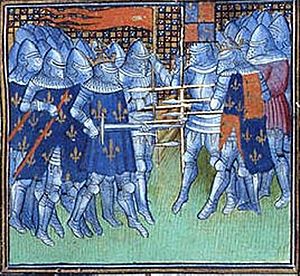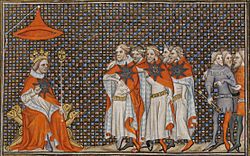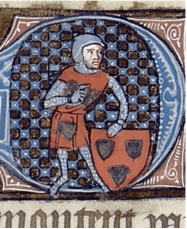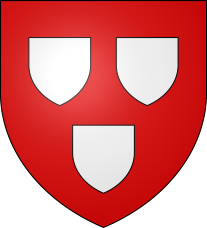Geoffroi de Charny facts for kids
Geoffroi de Charny (born around 1306 – died September 19, 1356) was a very famous knight from France. He was the third son of Jean de Charny, a lord, and Marguerite de Joinville. His grandfather, Jean de Joinville, was a close friend and biographer of King Louis IX.
Geoffroi de Charny was known for his bravery and skill in battles during the early years of the Hundred Years' War. He also wrote a poem called The Book of Geoffroi de Charny and questions about knightly behavior. He was also connected to the first known displays of the Shroud of Turin.
In 1344, he joined a successful crusade to Smyrna. After returning, King Philip VI made him a royal advisor and the bearer of the Oriflamme. This was France's sacred battle flag. Carrying the Oriflamme meant he was a main target for enemies. He died heroically protecting it during the Battle of Poitiers in 1356. Geoffroi de Charny was one of the most respected knights in Europe during his time.
Contents
A Knight's Early Life and Battles
Geoffroi de Charny was the third son in his family. This meant he did not inherit his father's land. So, he had to earn a living by competing in jousts and tournaments. He became very skilled at these knightly sports.
When he married his first wife, Jeanne de Toucy, in 1336, he still did not own his own land. He lived at his wife's family home. He fought in the early battles of the Hundred Years' War.
In 1342, Charny led a cavalry charge at the Battle of Morlaix in Brittany. But the English had set a clever trap, and he was captured. He was taken to Goodrich Castle in England as a prisoner. He was allowed to return to France to find money for his ransom. He struggled to get the money he needed.
The Smyrna Crusade
Soon after, Geoffroi de Charny became a crusader. He took part in capturing the harbor fortress of Smyrna on October 28, 1344. This was a surprise attack by fast ships that caught the Turkish defenders off guard.
He was one of a few special knights praised for their bravery by Pope Clement VI. They had shown great courage during the battle.
Later Military Career
After returning to France, Charny joined a siege of Aiguillon. In August 1346, he was quickly sent north. His mission was to stop a Flemish army from taking the important town of Béthune. He succeeded in this mission.
This was a big success for him, especially compared to his king, Philip VI. The king was defeated by King Edward III at the battle of Crécy. France also lost the port of Calais. In 1347, King Philip made Charny a royal advisor and the bearer of the Oriflamme. He also put Charny in charge of protecting France's northern border and trying to get Calais back.
In 1349, a mercenary named Aimery of Pavia offered to help Charny recapture Calais. Aimery held the keys to one of Calais's gates and asked for a large payment. Charny got the money and led a daring night attack. But Aimery had tricked him and warned King Edward III. Charny was captured again and spent over a year in an English prison.
King Jean II paid a huge ransom for his release. After returning to France, Charny found Aimery and had him publicly executed for breaking his word. This was seen as a private matter of honor, not an act of war. Charny's first wife had died, likely during the Black Death. He remarried around 1354 to Jeanne de Vergy, who was much younger. They had a son, also named Geoffroi.
The Heroic Death of a Knight

In the spring of 1356, King Jean II and Charny took the Oriflamme from the abbey of St. Denis. They set off with the French army to fight an enemy group near Breteuil. Meanwhile, an English army led by Edward the Black Prince was raiding towns in the south of France. This forced King Jean and his army to change plans and deal with this new threat.
In mid-September, the English and French armies met near Poitiers. The commanders from both sides held a meeting. Charny was there. He knew how bloody the battle of Crécy had been ten years earlier. He suggested that they settle their differences with a "trial by combat" involving only a few fighters, instead of a full battle.
However, the French commanders were too confident they would win. They ignored Charny's advice. King Jean sent all three parts of his army against Edward the Black Prince's well-placed English forces. This battle became known as the battle of Poitiers. The French suffered a huge defeat.
Geoffroi de Charny was killed bravely, holding up the Oriflamme until his last breath. King Jean had to surrender soon after. Charny's body was first buried in a nearby convent. But in 1370, his remains were moved to Paris and reburied in a respected church. Sadly, his hero's tomb was destroyed during the French Revolution.
Geoffroi de Charny's Writings
Geoffroi de Charny wrote two main works:
- A poem called The Book of Geoffroi de Charny.
- A set of questions about jousting, tournaments, and war.
These writings are found in old manuscripts. For a long time, people also thought he wrote a longer book called Livre de Chevalerie or ‘Book of Chivalry’.

However, new discoveries have changed this idea. Two other manuscripts were found that were made for the Company of the Star. This was a French group of knights, similar to England's Order of the Garter. The Company of the Star only existed for one year, 1352. These new manuscripts also date from that year, so they were made during Charny's lifetime.
These manuscripts contain Charny's poem and his questions, but they do not include the Book of Chivalry. Experts now believe that the Book of Chivalry was probably written by his son, Geoffroi II de Charny. His son wanted to follow in his famous father's footsteps, including going on a crusade. It seems Geoffroi II included his father's works along with his own Book of Chivalry in a later manuscript to honor him.
The Shroud of Turin Connection
In 1353, Geoffroi de Charny started a church in his small area of Lirey. It's interesting that the church's official document doesn't mention that he had given a special cloth, believed to be Christ's shroud, to the church.
However, a bishop from Troyes wrote in 1390 that a cloth showing images believed to be from Christ's body was displayed there around 1356. The bishop at the time, Henri de Poitiers, investigated these claims. He reportedly stopped the displays because he believed the "shroud" was a clever artwork made by an artist of that time.
This cloth is still known today as the "Shroud of Turin." It is kept in the Turin Cathedral in Italy. We know this cloth is the same one from Charny's time because of a medieval pilgrim badge. This badge was found in Paris in the 1800s and is now in the Cluny Museum.
The badge shows two clergy holding a cloth with the same distinct image of a crucified body as the Shroud of Turin. Below it are the coats of arms of the Charny and Vergy families. Because Charny's family symbol is in the main position, it seemed to suggest he was alive and in charge when the displays happened.
However, a new discovery in 2009 changed this idea. A casting mold for a Shroud pilgrim badge was found near Lirey. This mold is similar to the Paris badge but has important differences. On this new badge, Jeanne de Vergy's family symbol is in the main position, and Charny's is below it. Also, a label on this badge clearly reads "SVAIRE IhV," meaning "Shroud of Jesus."
This suggests that Geoffroi de Charny's young wife, Jeanne de Vergy, was in charge of these displays. They likely happened shortly after Charny's death in 1356, not before. The badge found in Paris was probably made later by Charny's son, Geoffroi II de Charny, for displays he held in 1389.
Even with these new findings, it is still commonly believed that Geoffroi de Charny was the first known owner of the Shroud. Both his son and granddaughter later said that he had acquired it. However, during his lifetime, Charny never spoke publicly about owning the Shroud or tried to make money from it.
See also
 In Spanish: Godofredo de Charny para niños
In Spanish: Godofredo de Charny para niños






